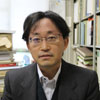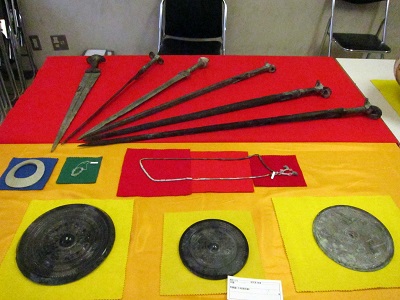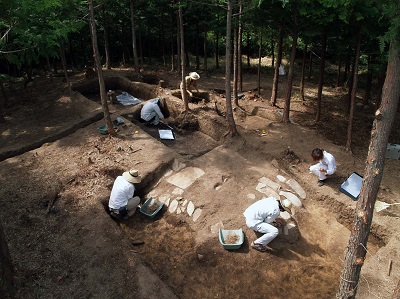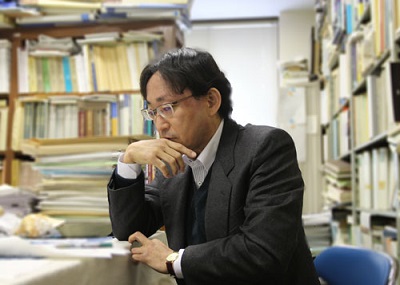Hisashi Nojima. "Emergence and Development of Burial Mounds in the Yayoi Period, as noted in excavations at the Satadani-Satadao Burial Mound Group [Hiroshima Ken Hokubu ni Okeru Yayoi Funkyū-bo no Seiritsu to Tenkai]".Bulletin of the Department of Archaeology No.7.Hiroshima University, 2015, p.1-12.(Japanese)
Graves dating from ancient times often take the form of mounds of earth and stones, commonly called burial mounds. One of the typical types of burial mound found in Japan comprise of a mound with four corner projections (yosumi tosshutsugata funkyubo). Few are aware that the cradle of this type of burial mound is the northern part of Hiroshima Prefecture in Western Japan. Excavations have illuminated the evolution of burial mound construction methods and funeral rites.

Hisashi Nojima
Graduate School of Letters, Professor
Research Fields: Humanities;History;Archaeology
Ancient burial mounds from the Yayoi Period (c. 4th century BC to mid-3rd century AD) were found in the Sanin region and the surrounding Chugoku Mountains of Western Japan. The Yayoi Period burial mounds are considered the predecessors of later developed large keyhole-shaped burial mounds which incorporate a round rear portion in the Kofun (lit. burial mounds) Period (mid-3rd century AD to c. 6th century AD).

Back: Bronze-hilted iron swords from northern Iran (approx. 3,000 years old);
Foreground: Grave goods from burial mounds in Hiroshima pref. (approx. 1,700 years old)
For six years, starting in 2008, the Department of Archaeology of the Graduate School of Letters at Hiroshima University conducted excavations of the Satadani-Satadao burial mound group – a group of burial mounds found in the Satadani and Satadato areas in the Chugoku Mountains in northern Hiroshima Prefecture. The Satadani-Satadao burial mound group primarily comprises burial mounds with four corner projections (yosumi tosshutsugata funkyubo). These excavations clarify detailed aspects in the development of burial mounds that were established in the Sanin region and Chugoku Mountains in western Japan during the ancient Yayoi Period. One important result of the excavations was a newly acquired understanding of the process of change in burial mound construction methods.

Satadao burial mound No. 3;
Example of burial mound with four corner projections - Shobara city,
northeastern Hiroshima pref., Aug. 2008
Our study found that two types of mounds were commonly constructed in the Sanin region and the Chugoku Mountains during the Middle Yayoi Period – “mound last” type and “concurrent progression” type. The “mound last” type of construction means that mound is formed after individual graves are excavated. Then the burial is performed. In the “concurrent progression” type, the mound is formed through repeated layering after the grave is dug and the corpse is buried. The construction method for Satadao burial mound No. 3, constructed in the last third of the Middle Yayoi Period, was found to be the “concurrent progression” type. In contrast, Satadani burial mound No. 1, from the beginning of the Late Yayoi Period, proved to be a “mound first” type—meaning that the grave is filled with dirt, after which the excavation/digging of a mound (hole-shaped) is conducted. Demonstrating that, in later periods, there was a change from mound last type/concurrent progression type to “mound first” type.
Furthermore, changes in burial facilities and graveside rituals also occurred simultaneously. Satadani burial mound No. 1 demonstrates, for the first time, components such as stones arranged in lines at the base of the burial mound, large flat stones placed on the mound slopes, parts that protrude outward from the main mound (this feature later evolved into the rectangular front part of the keyhole-shaped mounded tombs), the introduction of wooden burial chambers housing wooden coffins, the placement of pebbles and large-sized vermilion-painted potteries, and burials where a large grave pit constitutes the main burial while surrounded by other peripheral burials in its vicinity. These elements were adopted in large or colossal burial mounds in other regions. This empirical evidence demonstrates that changes in burial mound construction methods were a catalyst for the changes in burial rites – their scale and pomposity, during the burials of chiefs.

Diagram demonstrating changes to funeral rituals in the Yayoi period
Excursion to Magdalenenberg burial mound, Villingen, Germany (4-6 Nov. 2015)
In sum, some features of the Satadani-Satadao burial mounds form the origins of large-sized burial mounds that were noteworthy in other regions during the latter part of the Late Yayoi Period. The changes observed in the Satadani-Satadao burial mounds have increased the significance of these ruins. In addition, this study incorporates the interconnectedness of burial mound construction methods and funeral rites, making it a fundamental study from the perspective of comparative archaeology regarding research on burial mounds in Japan and other countries.


 Home
Home